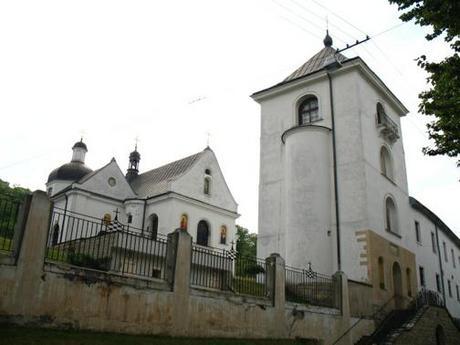St. Onuphrius Church
The Greek Catholic Church and Basilian Monastery of Saint Onuphrius (36 Bohdana Khmelnytskoho Street), a monument of the 16-19th centuries, holds a significant place in Ukrainian history and culture.
The St. Onuphrius Monastery is one of the oldest sanctuaries in the city; it functioned as early as the 13th century during the time of Lev, Prince of Halychyna. According to legend, the monastery owned an icon of the Virgin Mary which had been painted by St. Luke the Evangelist on a cypress panel. Emperor Constantine transferred the icon to his capital, whereupon Byzantine Princess Anna brought it with her from Constantinople to Kyiv. Three hundred years later this icon came into the possession of Prince Lev who handed it over to the Basilian Monastery. At the end of the 14th century this icon was eventually brought to Czestochowa in Poland, where it has become famous for its miracles. At present the ancient icon of the Virgin Mary of Czestochowa (the so-called Black Madonna) is viewed as the most sacred object in Poland.
Records mention a wooden church existed at this site already in the 13th century during the reign of Leo I of Halych. During the second half of the 15th century a monastery was built next to the church. A stone church was built in 1550 and in 1585 a monastery surrounded with fortifications. The church was destroyed and rebuilt several times. Damaged by Turks in 1672, it underwent a major reconstruction in 1680. In 1776 the church was connected with the previously separate chapel of the Holy Trinity, adjoining it to the north, a new classicist bell tower was built in 1820 and in the years 1821-1824 the presbytery was extended and a sacristy added. The churches present day look dates to 1902 when the southern nave was constructed symmetrically and both were toped with hexagonal domes. Inside the church holds 18th century polychromies and an iconostasis from 1908.
The monastery of the princely era has not survived in its original form. The construction of a stone church began in the middle of the 16th century and was financed by Prince Kostyantyn Ostrozky, the biggest benefactor of culture in Ukraine. In the 17th century this complex of buildings located far from the city walls suffered from fires and numerous attacks by enemy invaders. Subsequent constructions and reconstructions of the monastery occurred throughout the next four hundred years, and were finally completed in 1902, when achapel was added to the church’s right flank.
Throughout the course of its history the monastery functioned under the auspices of the Stauropegian Brotherhood of the Assumption Church. A school, hospital, library, archives, and museum were established there. It was this monastery where in 1573 Ivan Fedorov – ‘a printer of books never seen before’ – took refuge. The next year he produced the first printed book in Ukraine - the Apostle - in the monastery printing shop, which functioneduntil 1615. The first Ukrainian printer was buried in 1583 in the princely-era cemetery near the monastery.
The richly adorned iconostasis of the monastery church was created in the 18th century by the prominent painter Luka Dolynsky. New icons by the hand of artist Sosenko wereadded at the beginning of the 20th century.
St. Onuphrius Church is part of the medieval history of the city. Tourists can get there by flights to Lviv or Kiev.


